
Morocco displays its cultural wealth
The depth, diversity and distinctiveness of the cultures of the Kingdom of Morocco was showcased in of two exhibitions on the sidelines of this year’s meetings of WIPO Assemblies. WIPO Magazine brings a taste of what was on offer to its readers.
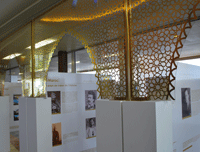
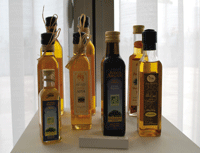
Photos: WIPO/C. Jewell
A feast for the senses
The exhibition sponsored by the Government of Morocco offered a sumptuous glimpse of the country’s unique heritage, rich cultural diversity and extensive biological resources.
At the crossroads between sub-Saharan Africa, Europe and the Middle East, the Kingdom of Morocco is “a place where civilizations meet and cultures converge.” Its unique geographical location and historical heritage have influenced and shaped the country’s distinctive personality, enabling the development of an amazing wealth of art forms. These range from architecture, calligraphy and metalwork, to pottery, leather and woodwork, weaving and jewelry-making – each combining tradition with modernity. Crafts and products from ceramics to kaftans and saffron to tagines were on display.
“A country at the heart of history, a country where art is culture, a country strengthened by its cultural diversity, a country of exceptional genetic resources, a country with an eye to the future, a land of hospitality” (Anis Birrou, Secretary of State in Charge of Handicrafts)
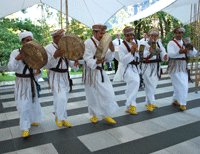
The exhibition offered a flavor of the dynamism and vitality of Moroccan culture, reflecting age-old traditions and modern creative trends. Morocco has taken a number of measures to highlight the “excellence and authenticity” of its products and to protect and preserve its “tangible and intangible national heritage.” Its agricultural policy, for example, known as the “Green Morocco Plan”, places special emphasis on the development of local products to promote sustainable and viable local development and foster a “truly modern” sector that offers “a wide range of quality products with high added value” for local and international markets.
At the opening of the exhibition on the first day of the WIPO Assemblies meetings, Morocco’s Ambassador to the United Nations in Geneva, His Excellency Omar Hilale, underlined that protecting the country’s heritage was one of his Government’s priorities. He stressed that effective legal protection was an essential safeguard against illegal reproduction and would enable the crafts sector to continue to flourish.
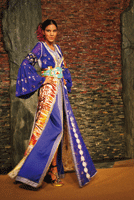
WIPO Director General Francis Gurry said that the rich and varied display of Moroccan culture offered “a prism” through which to “experience the distinctive creative heritage that is so integral to Morocco’s global identity.” He applauded the Moroccan Government’s commitment to promoting and preserving the country’s cultural wealth, which currently employs some 20 percent of the national labor force and accounts for over 10 percent of its gross domestic product (GDP).
At the start of the reception, guests were welcomed by a troupe of Allaoui performers which, to the accompaniment of drums and horns, performed a striking victory dance.
Later in the evening, guests were treated to a stunning fashion show featuring the colorful gowns of Moroccan designer Samira Hadouchi, whose work combines tradition with modernity, sophistication and elegance.
Ms. Hadouchi, who has designed for stars, including Whitney Houston, said the creativity in her work enabled her to reach new heights of expression and design. “Morocco is a country in which you can find a wide range of cultural influences and, through my work, I am able to express our unique cultural identity and to give it value,” she said. “Protecting the creativity of artists and designers like myself is key, and intellectual property is a really important means of doing this”.
The colorful and distinctive works of artist and master calligrapher Mohammed Amzil were also on display. Speaking about the significance of the ancient art of calligraphy to his own art , he said, “calligraphy is my oxygen… it’s a big sea of secrets… you find balance, movement, everything, because it is very supple.” Mr. Amzil underlined the importance of respecting the rights of creators: “to ensure the future of creativity”. “To copy a work is unpardonable,” he said. “When you love art, you have to love the artist, and to love him you have to think of his interests also.”
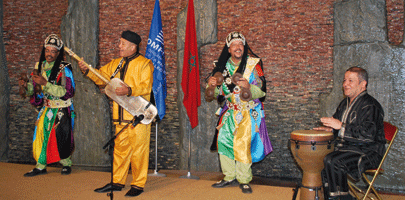
Throughout the evening, guests savored the rhythmic beat of the music of the Gnawa people for whom music holds a religious significance, enabling them to attain a trance-like state. These musical performances were but a taste of the rich musical traditions of the country where group dances are as numerous as its tribes and are associated with popular poetry.
The exhibition also featured Morocco’s rich genetic diversity - saffron, henna, argan oil, olive oil, figs, date palm, honey, roses and spices - variously used for medicinal, cosmetic and culinary purposes. These resources play a key role in fostering sustainable rural development.
The exhibition showed how Morocco’s cultural sector is constantly exploring new means of expression as new branches of creativity spring from the country’s traditional cultural roots. Contemporary designers, creators and craft workers are developing new designs and working with new materials and color combinations to renew and modernize their creations and to keep pace with evolving consumer tastes while preserving the authenticity that makes their works uniquely Moroccan.
The WIPO Magazine is intended to help broaden public understanding of intellectual property and of WIPO’s work, and is not an official document of WIPO. The designations employed and the presentation of material throughout this publication do not imply the expression of any opinion whatsoever on the part of WIPO concerning the legal status of any country, territory or area or of its authorities, or concerning the delimitation of its frontiers or boundaries. This publication is not intended to reflect the views of the Member States or the WIPO Secretariat. The mention of specific companies or products of manufacturers does not imply that they are endorsed or recommended by WIPO in preference to others of a similar nature that are not mentioned.